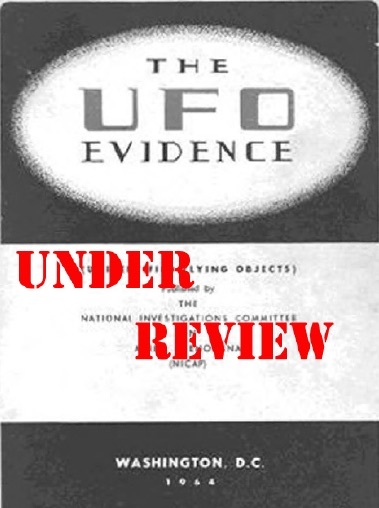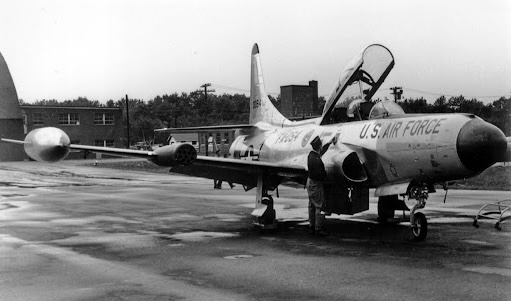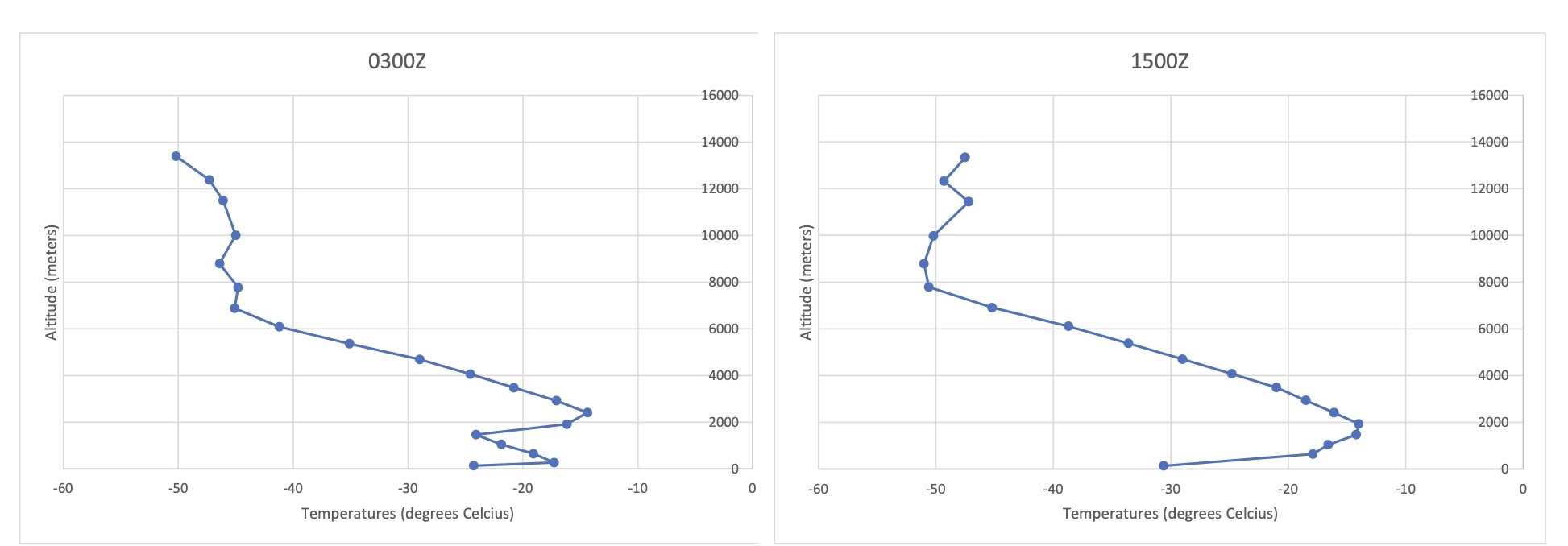18.04.2024

January 22, 1952 - North Alaska Radar outpost
January 22, 1952--North Alaska Radar outpost. Ground radar and three F-94 interceptors’ radar
tracked a distinct target. [VIII].1
Section VII states:
Three F-94s scrambled to intercept radar target; UFO maneuvered, ground radar saw object streak away to west.[16]2
Footnote 16 states that the information comes from Ruppelt’s book.
Ruppelt and Blue Book disagree Ruppelt writes the following about the case:3
Just twenty minutes after midnight on January 22, 1952, nineteen and a half hours after the Navy lieutenant commander had chased the UFO near Mitchel AFB, another incident involving an airplane and something unknown was developing in Alaska. In contrast with the unusually balmy weather in New York, the temperature in Alaska that night, according to the detailed account of the incident we received at ATIC, was a miserable 47 degrees below zero. The action
was unfolding at one of our northernmost radar outposts in Alaska. This outpost was similar to those you may have seen in pictures, a collection of low, sprawling buildings grouped around the observatory- -like domes that house the antennae of the most modern radar in the world. The entire collection of buildings and domes are one color, solid white, from the plastering of ice and snow. The picture that the outpost makes could be described as fascinating, something out of a Walt Disney fantasy—but talk to somebody who’s been there—it’s miserable.
At 0020, twenty minutes after midnight, an airman watching one of the outpost’s radarscopes saw a target appear. It looked like an airplane because it showed up as a bright, distinct spot. But it was unusual because it was northeast of the radar site, and very few airplanes ever flew over this area. Off to the northeast of the station there was nothing but ice, snow, and maybe a few Eskimos until you got to Russia. Occasionally a B-50 weather reconnaissance plane ventured into the area, but a quick check of the records showed that none was there on this night.

Boeing WB-50D of the 53d Weather Reconnaissance Squadron, USAF
By the time the radar crew had gotten three good plots of the target, they all knew that it was something unusual—it was at 23,000 feet and traveling 1,500 miles an hour. The duty controller, an Air Force captain, was quickly called; he made a fast check of the targets that had now been put on the plotting board and called to a jet fighter-interceptor base for a scramble.
The fighter base, located about 100 miles south of the radar site, acknowledged the captain’s call and in a matter of minutes an F-94 jet was climbing out toward the north.
While the F-94 was heading north, the radar crew at the outpost watched the unidentified target. The bright dots that marked its path had moved straight across the radarscope, passing within about 50 miles of the site. It was still traveling about 1,500 miles an hour. The radar had also picked up the F-94 and was directing it toward its target when suddenly the unidentified target slowed down, stopped, and reversed its course. Now it was heading directly toward the radar station. When it was within about 30 miles of the station, the radar operator switched his set to a shorter range and lost both the F-94 and the unidentified target.
While the radar operator was trying to pick up the target again, the F-94 arrived in the area. The ground controller told the pilot that they had lost the target and asked him to cruise around the area to see if he and his radar operator could pick up anything on the F-94’s radar.

F-94 USAF
The pilot said he would but that he was having a little difficulty, was low on fuel, and would have to get back to his base soon. The ground controller acknowledged the pilot’s message, and called back to the air base telling them to scramble a second F-94.
The first F-94 continued to search the area while the ground radar tried to pick up the target but neither could find it.
About this time the second F-94 was coming in, so the ground radar switched back to long range. In a minute they had both of the F-94’s and the unidentified target on their scope. The ground controller called the second F-94 and began to vector him into the target.
The first F-94 returned to its base.
As both the second F-94 and the target approached the radar site, the operator again switched to short range and again he lost the jet and the target. He switched back to long range, but by now they were too close to the radar site and he couldn’t pick up either one.
The pilot continued on toward where the unidentified target should have been. Suddenly the F-94 radar operator reported a weak target off to the right at 28,000 feet. They climbed into it but it faded before they could make contact.
The pilot swung the F-94 around for another pass, and this time the radar operator reported a strong return. As they closed in, the F- 94’s radar showed that the target was now almost stationary, just barely moving. The F-94 continued on, but the target seemed to make a sudden dive and they lost it. The pilot of the jet interceptor continued to search the area but couldn’t find anything. As the F-94 moved away from the radar station, it was again picked up on the ground radar, but the unidentified target was gone.
A third F-94 had been scrambled, and in the meantime its crew took over the search. They flew around for about ten minutes without detecting any targets on their radar. They were making one last pass almost directly over the radar station when the radar operator in the back seat of the F-94 yelled over the interphone that he had a target on his scope. The pilot called ground radar, but by this time both the F-94 and the unidentified target were again too close to the radar station and they couldn’t be picked up. The F-94 closed in until it was within 200 yards of the target; then the pilot pulled up, afraid he might collide with whatever was out in the night sky ahead of him. He made another pass, and another, but each time the bright spot on the radar operator’s scope just stayed in one spot as if something were defiantly sitting out in front of the F-94 daring the pilot to close in. The pilot didn’t take the dare. On each pass he broke off at 200 yards.
The F-94 crew made a fourth pass and got a weak return, but it was soon lost as the target seemed to speed away. Ground radar also got a brief return, but in a matter of seconds they too lost the target as it streaked out of range on a westerly heading.
As usual, the first thing I did when I read this report was to check the weather. But there was no weather report for this area that was detailed enough to tell whether a weather inversion could have caused the radar targets.
But I took the report over to Captain Roy James, anyway, in hopes that he might be able to find a clue that would identify the UFO.
Captain James was the chief of the radar section at ATIC. He and his people analyzed all our reports where radar picked up UFO’s. Roy had been familiar with radar for many years, having set up one of the first stations in Florida during World War II, and later he took the first aircraft control and warning squadron to Saipan. Besides worrying about keeping his radar operating, he had to worry about the Japs’ shooting holes in his antennae.
Captain James decided that this Alaskan sighting I’d just shown him was caused by some kind of freak weather. He based his analysis on the fact that the unknown target had disappeared each time the ground radar had been switched to short range. This, he pointed out, is an indication that the radar was picking up some kind of a target that was caused by weather. The same weather that caused the ground radar to act up must have caused false targets on the F-94’s radar too, he continued. After all, they had closed to within 200 yards of what they were supposedly picking up; it was a clear moonlight night, yet the crews of the F-94’s hadn’t seen a thing.
Taking a clue from the law profession, he quoted a precedent. About a year before over Oak Ridge, Tennessee, an F-82 interceptor had nearly flown into the ground three times as the pilot attempted to follow a target that his radar operator was picking up. There was a strong inversion that night, and although the target appeared as if it were flying in the air, it was actually a ground target.
Since Captain James was the chief of the radar section and he had said “Weather,” weather was the official conclusion on the report. But reports of UFO’s’ being picked up on radar are controversial, and some of the people didn’t agree with James’s conclusion.
A month or two after we’d received the report, I was out in Colorado Springs at Air Defense Command Headquarters. I was eating lunch in the officers’ club when I saw an officer from the radar operations section at ADC. He asked me to stop by his office when I had a spare minute, and I said that I would. He said that it was important.
It was the middle of the afternoon before I saw him and found out what he wanted. He had been in Alaska on TDY when the UFO had been picked up at the outpost radar site. In fact, he had made a trip to both the radar site and the interceptor base just two days after the sighting, and he had talked about the sighting with the people who had seen the UFO on the radar. He wanted to know what we thought about it.
When I told him that the sighting had been written off as weather, I remember that he got a funny look on his face and said, “Weather!
What are you guys trying to pull, anyway?”
It was obvious that he didn’t agree with our conclusion. I was interested in learning what this man thought because I knew that he was one of ADC’s ace radar trouble shooters and that he traveled all over the world, on loan from ADC, to work out problems with radars.
“From the description of what the targets looked like on the radarscopes, good, strong, bright images, I can’t believe that they were caused by weather,” he told me.
Then he went on to back up his argument by pointing out that when the ground radar was switched to short range both the F-94 and the unknown target disappeared. If just the unknown target had disappeared, then it could have been weather. But since both disappeared, very probably the radar set wasn’t working on short ranges for some reason. Next he pointed out that if there was a temperature inversion, which is highly unlikely in northern Alaska, the same inversion that would affect the ground radar wouldn’t be present at 25,000 feet or above.
I told him about the report from Oak Ridge that Captain James had used as an example, but he didn’t buy this comparison. At Oak Ridge, he pointed out, that F-82 was at only 4,000 feet. He didn’t know how the F-94’s could get to within 200 yards of an object without seeing it, unless the object was painted a dull black.
“No,” he said, “I can’t believe that those radar targets were caused by weather. I’d be much more inclined to believe that they were something real, something that we just don’t know about.”
This was Ruppelt’s account. Remember, Ruppelt had a tendency to exaggerate in a lot of his accounts I have reviewed in the past. This seems to have been the case again here. The Blue Book file has the following information in the file4:
•At 1020Z on 22 January, the radar at Murphy’s dome (An AN/CPS-6B) observed an unidentified target. It was moving away at an azimuth of 210 degrees at 1500mph. It then reversed course and appeared to come back towards the station. When the radar was adjusted, the target returned to its original location. It appeared to once again move away and return before it faded.
•At 1030Z, an F-94 was aloft and sent to search for the target but the target faded away before the F-94 could be directed towards it.
•At 1052Z, the radar acquired the target again for about 1 minute. It did not have time to vector the F-94 towards it before it faded.
•At about 1055Z, the F-94 was approaching Nenana and observed two targets on radar (AN/APG-33). One was faint and the other was bright. The radar operator indicated it was like a smaller ghost of the brighter target. The aircraft was at 30,000 feet and the target was at 24,000 feet. The operator could not lock onto the target.
•Nearly fifty minutes later, the radar operator picked up the target again. The F-94 got within 200 yards and then passed over the target’s location. It was not seen and radar lost the target. The aircraft circled the area twice without tracking or seeing anything.
•While the F-94 was tracked by ground radar, the target was not observed.
•A similar incident happened in the same area the following night.
Blue Book, as Ruppelt stated in his book, eventually concluded that the radar targets were probably due to weather. Ruppelt also may have confused his story about the number of the F-94s and merged the two nights of observations as one night. In any case, Ruppelt’s account seems to not exactly agree with the known facts. As for his little conversation with the unnamed officer who was TDY at the time, I don’t give it much credence. “A friend of mine told me....” stories are not very credible. At best, it is second hand.
At worst, it sounds made up.
Analysis
Blue Book considered it was possible that the source of the radar targets was the weather. Radiosonde data is limited but there was data from nearby Fairbanks on the night in question at 0300Z and 1500Z5:

The bottom line is that there was a temperature inversion in the region that might have resulted in false targets being seen by the ground radar. The airborne target is interesting but one cannot be sure about it. It appears to have been seen in the same area over a period of two nights. It was not visible to the eye and disappeared when the jet passed through the area it was located. It seems possible that the air was disturbed by the jet’s passage through the area causing whatever was producing the target to disperse.

Conclusion
Once again, I am amazed at the inability of Ruppelt to tell the story accurately. To be honest, I don’t believe his story about the guy that was TDY to the base either. It sounds like he was just tying to make a good story sound better by introducing this individual that contradicts Blue Book. The fact that a temperature inversion did exist and nobody actually saw any object makes me conclude that Blue Book probably got this one right. I would consider this reclassified as probably Anomalous propagation and removed from the list of “best evidence”.
Quelle: SUNlite 1/2024
